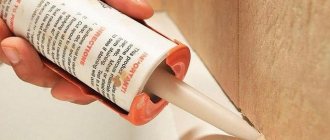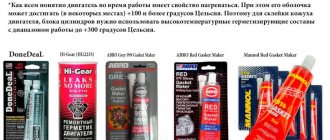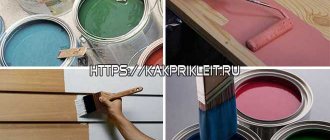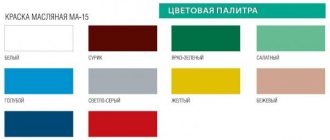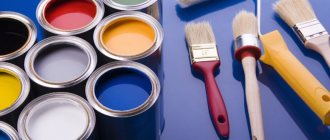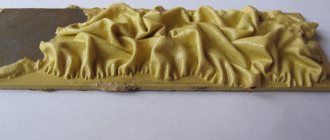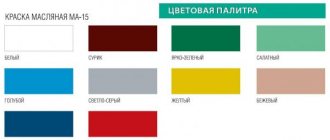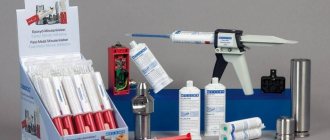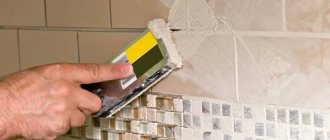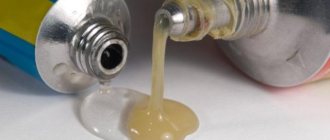When and for what is it used?
Most permanent pools are made of iron and concrete.
If the owner plans to enjoy it for many years, the walls and bottom of the bowl must be painted before use .
Concrete needs protection from the effects of water and the chemicals that are added to it; ultraviolet radiation and temperature changes also have a destructive effect on it. Therefore, when constructing a swimming pool, various insulating materials are used.
Pool paint has more than just a decorative function. It is also a replacement for various adhesives and mastics that are applied under tiles .
The coating composition is specially designed to protect the pool bowl from aggressive destructive conditions, so it is important to apply it immediately after the tank is ready, and also to ensure timely replacement.
Painting a pool costs less than tiling it, so if you're on a tight budget, it's best to choose this type of refinishing. In this case, you can also save money on doing the work - you need to hire a specialist to lay the tiles, but every homeowner can handle the painting.
Paint application is also suitable for creating an irregularly shaped bowl with a lot of curves. It is quite problematic to lay tiles on such walls; the only solution left is either mosaic or painting.
Rubber pool paint: pros and cons
Advantages of acrylic material
Rubber paint for swimming pools has a number of advantages that are not available to most paints and varnishes, namely:
- Increased waterproofing layer;
- Elasticity;
- Resistance to temperature changes;
- Resistance to mechanical deformation;
- High degree of adhesion;
- No peeling;
- Easy to apply using a spray gun or by hand;
- Profitable price;
- Versatility of use;
- Waterproof;
- No smell;
- Fire and explosion safety;
- Durability.
Rubber paint is characterized by increased resistance to the negative effects of the external environment, including sea water.
The presented type of paint and varnish products, when applied in two or more layers, has a striking difference from all previously invented products. In terms of tactile sensations, rubber paint literally resembles rubber, pleasant and soft. It can be used to cover any surface, as a result of which it will become matte-smooth, while removing the smallest nicks and cracks.
Learn how to connect a sand filter to your pool.
Prices for plastic bowls for swimming pools: .
Read what to feed crucian carp in the pond.
Rubber paint represents an innovation in water-based acrylic paints. According to environmental studies, the ingredients included in its composition do not pose any harm to the environment and human health throughout the entire period of operation , since no harmful substances are released.
Disadvantages of waterproofing
The only disadvantages include the prohibition of using it for painting furniture, floors or doors. You also need to be extremely careful with solvents that negatively affect rubber paint.
Possessing a wide range of color shades, rubber paint allows novice craftsmen and professional designers to play to their hearts’ content with the most original and daring solutions. The most commonly used color is blue for pool water.
Criterias of choice
When choosing a product for a pool, it is worth considering the material from which the bowl is made. Although the criteria for choosing paint will be similar due to the fact that a primer is applied before painting, each material still has its own nuances.
Qualities required for a concrete pool:
- High elasticity – for filling small roughnesses and irregularities.
- Low penetration - if the paint absorbs well, too much of it will be needed.
- Low water permeability - wet concrete deteriorates quickly, so good insulation is necessary.
- Good adhesion - it is important that the paint layer adheres well, which will prevent the concrete walls from collapsing.
Rubber, PVC and polyurethane paints are best suited for a concrete bowl.
Qualities required for a metal pool:
Low water permeability - to avoid corrosion of the material.- High level of adhesion - the paint should adhere well to a smooth surface.
- Resistance to destruction - moisture can penetrate through cracks in the paint, which provokes rapid corrosion.
- Transformation of corrosion - if there is already rust on the surface.
- Resistance to temperature differences - the heating and cooling times of metal and air are very different.
For metal surfaces, epoxy, rubber and acrylic paint are better suited.
General criteria:
- wear resistance;
- affordable price;
- ease of application;
- resistance to chlorine and other disinfectants;
- non-slip texture (relevant for the bottom and side around the pool).
How to choose the right composition
When choosing rubber paint, you need to consider the type of tank. Most often, pools are metal or concrete, as well as reinforced concrete.
Most compounds are universal and are suitable even for wood, with the exception of hydrostone.
For concrete pool
Best options:
- hydrostone;
- chlorinated rubber;
- acrylic.
See also
How and with what you can paint a refrigerator with your own hands at home
PVC is superior to other compounds in economy and durability. If the walls of the pool are not perfectly smooth, it is better to abandon the polyurethane coating.
For metal pool
The walls of iron tanks are characterized by poor absorption. Therefore, when choosing a coating, you need to pay attention to its adhesive properties. Epoxy paint adheres best to metal.
The best manufacturers
There are a large number of domestic and foreign manufacturers of pool paint.
Prestige
Russian company with twenty years of history. For use in water, it produces a latex composition under the “Prestige” brand. Used to insulate iron and concrete that are often underwater or in damp environments.
The paint does not react with cleaning chemicals, does not fade under the sun outdoors, and there is no unpleasant odor when the temperature increases. Non-slip after curing and can be applied to the edges of edges.
Characteristics:
- Type: latex.
- Blue color.
- Operating temperature: +5-+35ºС.
- Consumption: 120-160 g/sq.m.
- Number of coatings: 2-3 times.
- Break time between layers: 1 day.
- Complete hardening time: 14 days.
- Safety: A respirator and gloves are required for protection.
- Features: water is used for dilution.
- Price: 500-700 rubles/1 piece (2.4 kg).
For indoor and outdoor use. After work, the room must be ventilated.
Citadel
Rubber material for painting the bowl from the company LKM USSR. The main direction in which developments are being carried out is the creation of waterproof waterproofing materials.
The peculiarity of the composition is that it can be applied even at sub-zero temperatures. After drying, the coating does not react with water or chemicals for it.
Characteristics:
- Type: rubber.
- Color: variety of colors.
- Temperature during operation: -5-+35ºС.
- Consumption: 600-1000 g/sq.m.
- Number of applications: 2-3 times.
- Break time between applications: 2-3 hours.
- Time for final hardening: 2 days.
- Safety: Respirator and gloves required.
- Dilution: solvent, xylene, toluene.
- Price: RUB 3,700/1 piece (10 kg).
Tikkurila
Epoxy paint with hardener Reaflex 50 from the Finnish manufacturer Tikkurila.
Characteristics:
- Type: epoxy.
- Color: white, lagoon.
- Time after mixing: 4 hours.
- Consumption: 100-120 g/sq.m.
- Number of coatings: 1-2 times.
- Break time between coats: 48 hours.
- Time before water filling: 7 days.
- Safety: Respirator and gloves required.
- Features: Tikkuril 1074 hardener required.
- Price: 1450-1800 rub/1 piece (0.8 l).
The coating is glossy, so it is recommended to roughen the edges of the sides with sand.
Dufa
German manufacturer of paints and varnishes. To cover the pool, enamel is used for concrete, plastic and steel that are constantly or periodically in water.
Characteristics:
- Type: chlorinated rubber.
- Color: blue.
- Consumption: 100-120 g/sq.m.
- Number of coatings: 1-2 times.
- Break time between layers: 12 hours.
- Time before filling with water: 10 days.
- Safety: Respirator and gloves required.
- Dilution: solvent.
- Price: 900-1,300 rubles/1 piece (0.75 l).
The paint is semi-matte, non-slip, you can safely paint over the bottom of the tank.
Isaval
Proven product made in Spain. A brand with a long history, high-tech production and a large selection of paints and varnishes. Pool painting is manufactured by Isaval Piscinas.
The composition is not affected by pool chemicals. Thanks to the non-slip texture, it can be used to cover the bottom and sides.
Characteristics:
- Type: chlorinated rubber.
- Blue color.
- Consumption: 120-160 g/sq.m.
- Number of coatings: 2 times.
- Break time between layers: 6-8 hours.
- Time before filling with water: 8-12 days.
- Safety: a respirator and gloves are required during the process.
- Dilution: solvent.
- Price: 4,000 rubles/1 piece (4 l).
Stancolac
Greek manufacturer with a worldwide reputation. For swimming pools it produces chlorinated rubber paint with the addition of resins 560 POOL PAINT STANCOLAC. The material is known for its large selection of shades and excellent adhesion to concrete surfaces.
Characteristics:
- Type: chlorinated rubber.
- Color: according to NOVA, RAL and NCS chart.
- Operating temperature: -10-+35ºС.
- Consumption: 120-160 g/sq.m.
- Number of coatings: 2 times.
- Break time between layers: 5 hours.
- Time before filling with water: 3 days.
- Safety: Respirator and gloves required.
- Dilution: solvent.
- Price: from 1,000 rubles/1 l (bottling).
The paint dries quickly and can be used for exterior and interior use.
Tutgum Dengal
The Israeli company of paints and varnishes Denber produces one-component pool paint with increased durability. Can be used for waterproofing concrete and metal tanks with fresh and salt water.
Characteristics:
- Type: polymer.
- Color: blue.
- Consumption: 160-200 g/sq.m.
- Number of coatings: 2 times.
- Break time between coats: 4 hours.
- Time to fill with water: 6 hours.
- Safety: in case of contact with mucous membranes, rinse with water.
- Dilution: solvent D20.
- Price: 2,500 - 3,000 rubles/1 piece (2.5 l).
Resistant paint, not afraid of aggressive environments, does not chip under physical impact.
Why paint a concrete bowl?
The main purpose of finishing is to give the concrete maximum water resistance .
The strength and service life of the tank depends on the correct and high-quality painting procedure. For bowls located indoors, internal waterproofing is sufficient. It protects the surface from harmful substances contained in water. The destruction of the base is caused by their penetration through small cracks.
If the pool is installed in an open area, external finishing is also required. It is designed to protect the bowl from the negative effects of groundwater and the following external factors:
- Ultraviolet radiation.
- Temperature changes.
- Cleaning with chlorine-containing disinfectants.
- Water pressure.
- Mechanical damage.
Polyacrylic resins in the paint make it resistant to moisture. The surface becomes more elastic, and its expansion and contraction does not damage the appearance.
How to calculate the amount of material?
Each manufacturer writes the usage rate on the packaging at the rate of grams per square meter. This data must be applied to your own pool and multiplied by the number of layers. You can use the calculator on the seller’s website or calculate everything manually.
First you need to calculate the area of each tank wall and bottom and add these numbers:
- S1 (bottom)=length*width;
- S2 (walls)=height*width;
- S3 (walls)=height*length;
- S (pool)=S1+S2*2+S3*2.
The area of each alcove or recess, if any, is calculated separately. After this, the consumption indicated by the manufacturer is multiplied by the number of square meters. It is recommended to add 5-10% to the final volume.
For a pool with a square bowl, it is easier to calculate the amount of paint, because the walls will have the same area :
- S1=4*4=16 sq.m.;
- S2, S3=4*1.5=6 sq.m.;
- S=6*4+16=40 sq.m.
For example, let’s take paint with a consumption of 180 g per 1 sq.m. 180*40=7 kg 200 g. This is how much paint will be needed to apply one layer. If painting will be done in 2 or 3 (for an old surface) layers, the amount of paint must be multiplied by this number.
Example for a rectangular pool:
- S1=8*4=32 sq.m.;
- S2=1.5*4=6 sq.m.;
- S3=1.5*8=12 sq.m.;
- S=32+6*2+12*2=68 sq.m.
Let's take 120 g/1 sq.m. of paint per painting. 120*68=8 kg 160 g per layer.
Painting a concrete pool with liquid blue paint
It is advisable to carry out preparatory work in stages:
- Sand;
- Putty, then sand;
- Treat with primer;
- Degrease the surface;
- Sand all glossy surfaces, if any, to a matte finish;
- Rinse the area with water and dry.
If desired, in order to improve the protective properties and reduce paint consumption, after thorough processing, auxiliary layers of putty, primers, and antiseptic compounds can be applied.
Before directly applying liquid rubber, it is important to adhere to the following rules:
- Mix the paint thoroughly before use;
- If necessary, dilute the paint with water, although this is often not required;
- Apply to a dry surface with a brush or roller in a couple of layers. If you work with a sprayer, make sure that the temperature does not drop below five degrees.
- When working, stir the paint product regularly;
- Apply the next layer exclusively to the dried surface of the previous one;
- When finished, be sure to thoroughly rinse your tools.
This material will tell you what rubber coating is for children's playgrounds in the country.
After painting, try to maintain the coating regularly. It is not particularly difficult, but will allow the rubber paint to serve you for a long time. To do this, it is enough to periodically monitor the surface and, if necessary, carry out restoration of the pool:
- Remove rust;
- Apply sealant;
- Carry out coloring.
Washing with soapy water and treating with an antiseptic is allowed.
Swing lounge chairs for a summer house with a canopy are very comfortable.
Reviews of fecal pumps with a grinder: .
Watch the video on how to make a heated greenhouse with your own hands.
Painting technique
In order for the paint to last for many years, it is very important to follow the surface preparation and coating technology. Some compositions have their own application characteristics, but the preparation basically looks the same:
The reservoir is emptied of water (if the pool has already been used) and dried well.- The walls and bottom of a metal pool are cleaned of old paint and rust, and a concrete pool is cleaned of old paint and flaking pieces of cement.
- The entire surface is etched with acid mixed with water 1 to 1.
- The bowl is washed with water and dried.
- Chips and cracks are covered with cement or other adhesive.
- All debris and dust are removed.
- Leveling putty is applied to the surface. Before using it, it is recommended to degrease them.
- Most types of paint require priming the walls before painting. This is done either with a special primer or with the same paint, but diluted to a more liquid consistency.
- The soil should dry in 8-10 hours.
- The paint is applied either with a roller and brush, or with a spray gun.
- Each layer must be given the curing time specified by the manufacturer.
- The pool is filled with water only after the paint has completely dried.
This video will show you how to paint a pool:
What outdoor pools can be painted with it?
Often the bowls of outdoor pools are made of concrete. Before tiling the pool, a reinforced mesh is placed on the bowl, after which the tiles are laid. Rubber paint can be applied to both tiles and concrete bases to give a finished and aesthetic look to the new object. Using dark paint will significantly save the cost of heating the pool.
Find out about the types of in-ground pools for your summer cottage at this link.
Another option for installing a summer outdoor pool is to purchase an inflatable rubber one. The feasibility of painting such a pool does not raise any questions, since the rubber coating layer can protect the inflatable surface, as a result of which the pool will serve for many years.
Stages of preparation for painting
Before you begin choosing a coating, you need to prepare the pool bowl for applying the finishing coat. Preparation consists of several stages:
- Prepare the surface: it should be dry. Concrete gains strength within 28 days, and this period must be met;
- if we have a new bowl, we remove the construction dust, if it is old, we remove the previous layer of paint and also remove the dust;
- We prime the bowl using special solutions. Pool primer creates a monolithic thin layer with concrete and provides better paint coverage;
- direct coloring.
